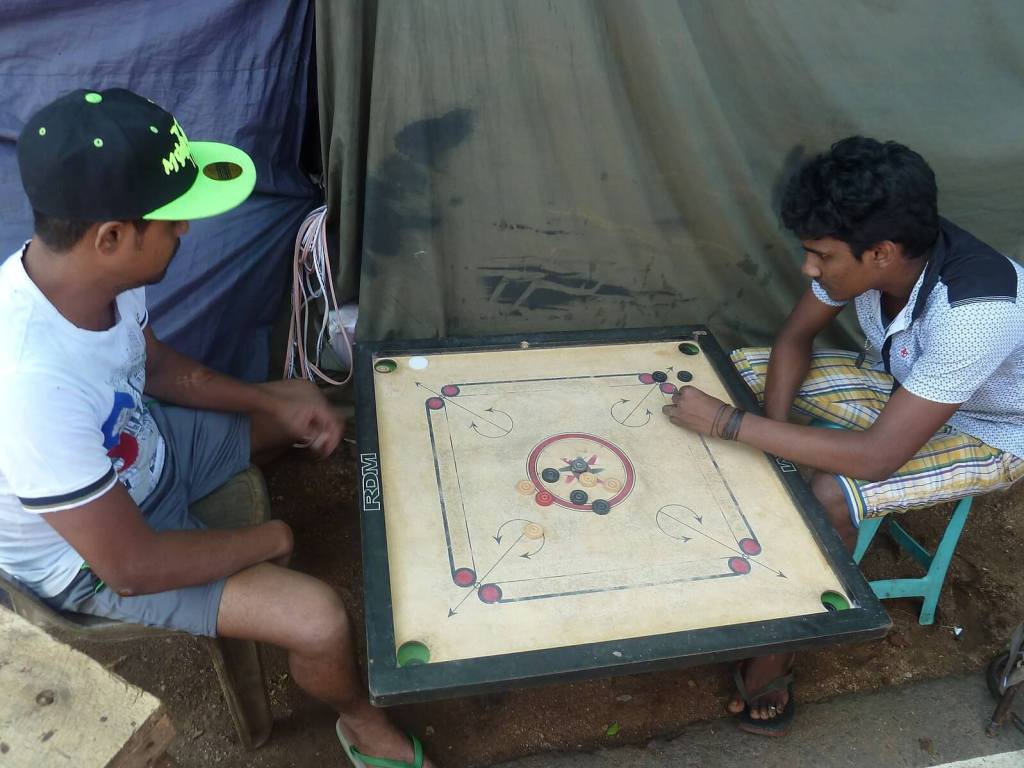How to play Burmese billiards
With gambling banned for citizens of Myanmar and playing cards previously illegal due to their association with gambling, many of the country’s traditional street games are based around balls and counters. By far my favourite game that I came across whilst visiting this amazing country was Burmese Billiards.
This guide will cover everything you need to know about the game, including how to play Burmese billiards, what it is, rules, tips and more. But watch out! The game can become extremely addictive (and competitive) once you get the hang of it!
What is Burmese Billiards?
Billiards is a game that is played all over the world. In different countries, there are plenty of different strains of the game. The equipment may vary but the basic concept is similar.
Essentially you have to try to get the balls or counters into the pocket before your opponent in order to reach a higher score.
Burmese Billiards is particularly similar to a game called Carrom (or Karom) which originated in neighbouring India. In this game, there are no cues and no balls. Instead, you use your hands to flick a heavy counter (or “striker”) into other smaller counters, trying to knock them into the pockets.
Burmese billiards is often referred to as “finger-pool”.

How to play Burmese Billiards?
Number of players
2 or 4 players. For two-player games, sit opposite your opponent. For four-player games (doubles), sit opposite your teammate and take turns going clockwise.

Equipment
- Square-shaped, flat board with a pocket in each corner. Usually around 74cm (29 inches) wide, however, I have seen variants where the board is rectangular and more similar to a pool table. The board should be positioned around 60-70cm off the floor, but for a casual game, I don’t think it matters too much as long as you can play comfortably.
- 9 Counters of one colour + 9 counters of another colour + 1 counter of unique colour (“the queen”). These small discs tend to be around 3cm in diameter and can be made of either wood or plastic.
- Striker. A heavier counter, around 4cm in diameter used to bounce the smaller counters into the pockets.
- Powder/Chalk. Used to sprinkle on the board to reduce friction and ease the sliding of the striker and counters.
Rules
Setup
Arrange the smaller counters in the middle of the board with the queen piece in the very centre. You should be able to make a hexagonal shape where the counters of different colours are evenly distributed. Ensure that all the counters are within the circular boundary drawn on the board.
Having played Burmese billiards probably a few too many times, I learnt to just push all the pieces in the middle together and hope that it’s roughly fair. It saves precious time when you’re eager to play again!

Who goes first?
Grab a counter of each colour in either hand. Let your opponent guess which colour counter is in which hand. If they are successful then they can break, if not, then you get to go first.
Or just flip a coin!
Striking and Playing
Each turn, the striker must be positioned on the horizontal lines closest to you. It must overlap both lines since crossing just one of the lines is a foul shot. The striker may not overlap any of the perpendicular lines running along either side nor may it overlap the shorter diagonal arrows in each corner.
When you go to flick the counter, it has to be one movement in a forward direction. You cannot push it from above to guide its course. It doesn’t matter which colour counters you hit, nor does it matter if you do not hit any counters.
For the opening break, you flick the striker forwards from the lines into the counters.
You take it in turns to flick the striker, trying to pot a counter into the pocket.
Like a game of pool, the first counter potted assigns the teams to a colour. For example, if you get the first counter of the game into the pocket and it is yellow, you will be trying to pot yellow for the rest of the round and your opponent will be ther other colour.
If you pot successfully, it is your turn again. You switch turns after you are not successful.
The aim of the game is to pot all of your colour counters and then make your way onto the queen. Once you pot the queen, you are victorious!
Fouls
Fouls in this game are committed by:
- Not flicking the striker correctly (double hits, dragging it, not flicking it forward)
- Potting an opponent’s piece
- Potting the queen too soon
- Moving the board or adjusting the counters
If at any point in the game you commit a foul, then one of your counters is returned to the game in the centre of the board. If you pot the queen too early, like pool, the game is over and you lose that round.
Note that, if you are yet to pot a counter and you commit a foul, then the first piece you pot after that will be returned to the centre of the board.
Variants of Burmese billiards
As with many games that have been made on the streets, there are bound to be geographical variations. And boy did I come across a lot across Burma!
Numbered counters
Instead of playing a game where you can shoot for any counter of your colour. There are adaptations of the game where players have to pot the counters in numeric order. Counters are all the same colour and numbered 1 to 19 and whoever has potted the most counters at the end of the game is the winner.
I’ve also seen variations where dice have been used to generate numbers to go for, though I am yet to figure out how this works!
Counters with points
Each of the colours is assigned a value. One colour counter is worth 5 points, the other colour is worth 10 points and the queen is worth 20 (sometimes 30) points. You are allowed to pot any of the counters at any time, other than the queen which once again is left until the end.
The good thing about this game is that you can play with 2, 3, or 4 players, where everyone is on a different team!
The rules are the same, just instead the aim is to get the most points at the end. Not necessarily the most counters potted. Though that obviously helps!
Playing with cards
When I visited Myanmar, I wasn’t aware of anyone using playing cards along with this game. However, there are meant to be several adaptations of Burmese billiards where playing cards are involved.
If you know how it’s played, please hit me up!
Potting the Queen Variations
There are several variations of the game regarding when you pot the queen. As explained earlier, many people play with the queen as the last counter you are meant to pot. However, some people play the game with rules that mean that the queen has to be played second to last.
Similarly, some play the game where the queen may be potted at any point in time as long as the queen is “covered.” This means that a normal counter must be potted after the queen.
Since the queen is not the last counter-potted in these variations, it means that both players may need to pot the queen in a particular round. Therefore, once one player has potted the queen, it must be returned to the centre once again. Once both players have potted the queen, it can be left in the pocket.
Penalty Variations
If you pot the queen at the wrong time then all of your potted pieces come out again and you continue playing. This is a great rule if you do not want to repeatedly restart the whole game should someone accidentally pot the queen!
Some people play a version where should you pot an opponent’s piece, you are not punished at all and do not need to return one of your counters to the board. Often getting a counter potted for you by your opponent is viewed as advantage enough.
With many of these variations and adaptations, it gives you the freedom to shape the game to make it as enjoyable for you as possible. So be as inventive as you like and create your own rules too!
Tips, tactics and techniques
- It is easier to pot a counter that is already close to your line than one far away. So if you have the choice, shoot for the counters closer to you.
- If you try to get your opponent’s counters behind their playing line it makes it tougher for them to pot since they will have to bounce it off another side to get back there.
- When flicking the counter you can either use the scissor grip or the straight grip. From personal experience and watching some far better players than myself, the straight grip seems to provide more control and accuracy. I would therefore recommend this for beginners. The scissor grip may be more comfortable and can offer more power. Practicing flicking the striker is the only way to figure out which method you prefer.
Though simple in concept, Burmese billiards is a tricky game to master! I learnt to play with some of the staff at Ostello Bello Pool Hostel in Bagan where a couple of friendly staff challenged us to a game and offered to teach us.
Since then, it has become one of my favourite games to play, and some of my fondest memories of visiting Myanmar!
Before you go
Thank you for reading this post on how to play Burmese billiards. If guides, itineraries and travel content like this interest you, head over to my blog page to find out more.
If you are new to Matt’s Next Steps, check out the About Me page to find out a bit more about who I am, my travel adventures, and why I wanted to become a travel writer.
Please comment below and let me know your thoughts and experiences, or if there is anything else you want information on.
Happy travelling!





No Comments